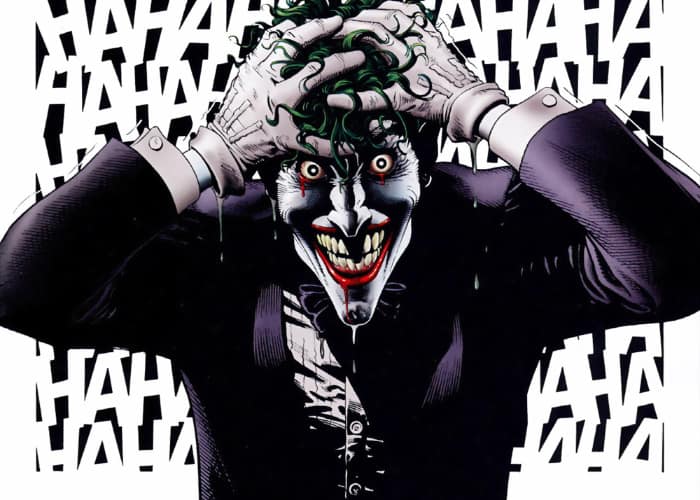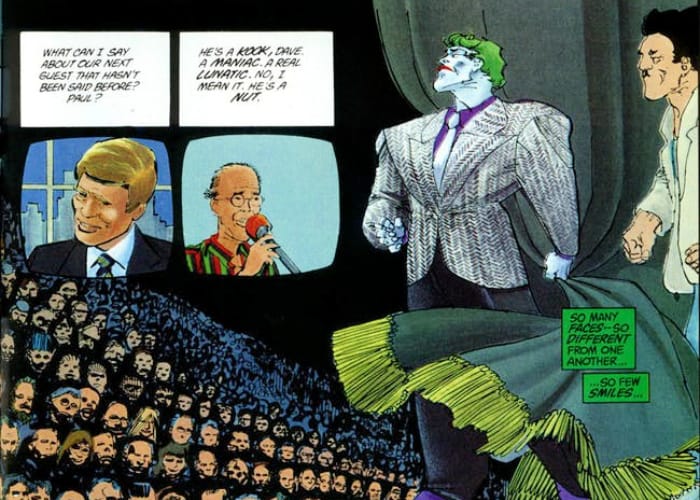For every interpretation of the Joker on screen, there are hundreds more represented in the comic books. Eighty years with the same characters breeds an astonishing amount of creativity. Riding high (or grinding pretty damn low) after watching the Todd Phillips/Joaquin Phoenix version of the character, you may want to venture into the funny books for a few more laughs. There are a lot of classic works to devour, and that’s where our Reading List begins, but there are also several lesser-known titles that need your love. By this point, with good reason, we all know about Alan Moore and Frank Miller. How about J.M. DeMatteis and Tom King? You’ve got good stuff in your future.
Joker names seven comic book creators as influences towards the end of the credits. Batman originators and Gotham City architects Bill Finger and Bob Kane get top billing, followed by Joker artist Jerry Robinson. I won’t spoil the somewhat surprising four other additions to the contributor roster here, but each one makes an appearance in the reading list below.
![]()
Batman: The Killing Joke

When people imagine the Joker, after they’re done arguing over which actor captured his essence the best, Batman: The Killing Joke is the first comic book interpretation that springs to mind. You will not find a Joker-centric list on the internet without its inclusion. Published in 1988 as a one-shot graphic novel written by Alan Moore and illustrated by Brian Bolland, the story centers on the Joker’s escape from Arkham Asylum and his dogged pursuit to break Commissioner Gordon’s “no-kill” policy.
As we see through a series of flashbacks, the Joker was once a put-upon chemical engineer with dreams of stand-up celebrity. The only problem? No one thinks he’s funny. Unable to support his pregnant wife, the unnamed Joker agrees to escort a couple of goons through his former workplace’s security system. They convince him to wear the mantle of The Red Hood, a criminal mastermind who doesn’t actually exist but acts as a decoy to confuse Gotham police. It works, and the Joker becomes the target of the Batman at the scene of the crime. Startled, the foolish wannabe comedian jumps into a vat of chemical waste, and the Clown Prince of Crime is born.
Brian Bolland is one of the four other artists listed in the credits of the new film. Moore is noticeably absent, but the cantankerous author recently requested that none of his work-for-hire adaptations contain his name. While The Killing Joke‘s flashbacks were retconned in the comics, clearly they provided a nice backdrop for Todd Phillips’ The King of Comedy twist on Arthur Fleck’s psychology. The clown is a big baby screaming, “Hear me! See Me! Know me!” What ultimately separates the Joker from Batman is that he wants the world to experience the pain he’s suffered, while Bruce Wayne wants to prevent the world from knowing the hell he went through on that dark night in Gotham when he lost his parents. Everyone has “one bad day” in their timeline. In fact, many have multiple, but each of us chooses to confront those horrors in different ways. The question is, are you a selfish ass or a bold advocate for humanity?
The Dark Knight Returns

If The Killing Joke is the most famous Joker story, then The Dark Knight Returns is the most famous Batman story. Published two years prior and written by Frank Miller who also provides the art alongside Klaus Janson and Lynn Varley, the four-issue premium format series revolutionized the industry, luring in countless numbers of non-comic book readers at the time. Its success stains every Batman story going forward, and its obvious influence probably distracts from a lot of great work that has come since. I will never say anything negative about the book itself, but folks, there are so many other rad Caped Crusader comics out there. Let’s explore beyond the bestsellers.
The significance of The Dark Knight Returns as it applies to the Joker film is that the Live with Murray Franklin sequence that explodes into violence near the climax feels very similar to a moment from the comic. In Book Three, “Hunt The Dark Knight,” the Joker lures Batman into conflict when he appears as a guest on Late Night with David Letterman. Akin to the movie, he appears on the couch next to a Dr. Ruth Westheimer type and gives her a smooch right before he murders the entire studio audience with Smylex gas. He escapes, but Batman tracks him to a county fair where they battle in the Tunnel of Love. The Dark Knight refuses to murder his opponent, so the pummeled Joker breaks his own neck, knowing that the Gotham Police will hunt Batman down for the killing.
Neither Miller, Janson, nor Varley is namechecked in Joker‘s credits, and Arthur’s confrontation with Franklin certainly has more in common with Martin Scorsese’s movie The King of Comedy than The Dark Knight Returns, but the inclusion of Dr. Ruth is a massive tip of the hat to the most renowned Batman comic book. Both Jokers demand an audience to justify a lifetime of rage and misery. They are nothing without the pain of others.
The post The ‘Joker’ Reading List appeared first on Film School Rejects.




0 comments:
Post a Comment